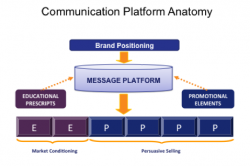Biopharma has unbranded message development backwards. There I said it! How in the world can you define your unbranded message platform if you don’t know where you’re headed with your brand message platform? Market education or development activities aren’t altruistic. These activities are supposed to educate the market in a way that helps the target audience understand how to appropriately use and differentiate your product quickly after launch.
 It has been our experience in applying Evidence-Based Marketing to communication development over the past 5 years that the identification of key educational messaging prescripts is essential for accelerating launch uptake. Educational prescripts are basically the unbranded messages that serve to quicken internalization of a promotional story and can be linked to intensified product adoption at launch. Quantitative evidence supports this.
It has been our experience in applying Evidence-Based Marketing to communication development over the past 5 years that the identification of key educational messaging prescripts is essential for accelerating launch uptake. Educational prescripts are basically the unbranded messages that serve to quicken internalization of a promotional story and can be linked to intensified product adoption at launch. Quantitative evidence supports this.
Recent work that we did related to a Client launch of a forecasted billion-dollar brand demonstrated (with a P value) that internalization of key educational prescripts prior to launch, not only increased onset of prescribing, but depth of prescribing as well. A subsequent study with early adopters provided additional evidence and validation of the criticality of educational prescripts in launch platform development. Uncovering these prescripts and incorporating them into the launch communication platform is essential for success in today’s market.
With educational prescripts in hand, only then are you able to define and invest in appropriate unbranded pre-marketing activities!